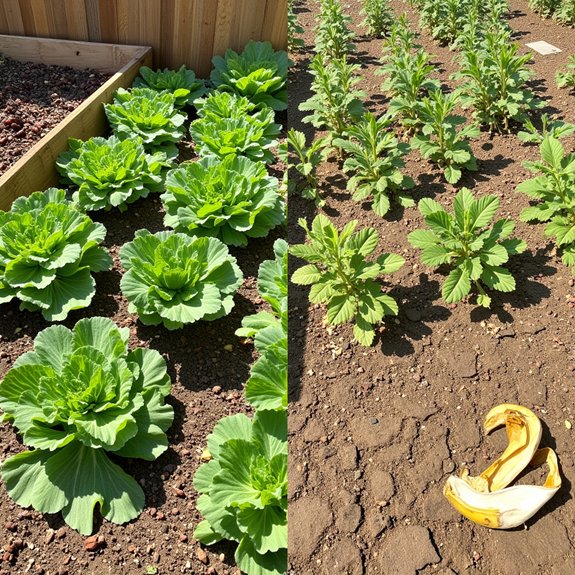If you’ve scrolled through gardening social media lately, you’ve probably seen banana peel water praised as the ultimate plant superfood that’ll transform your garden overnight. Before you start hoarding fruit scraps, though, you need to know what science actually reveals about this trending hack. The reality behind those glowing testimonials might surprise you, and understanding the facts could save your plants from some serious problems you didn’t see coming.
Contents
- 1 Understanding Essential Plant Nutrition Requirements
- 2 The Social Media Claims Behind Banana Peel Fertilizer
- 3 Scientific Reality of Potassium Content in Banana Peel Water
- 4 Hidden Risks and Unwanted Consequences
- 5 Why Comprehensive Nutrition Matters More Than Trending Hacks
- 6 Proven Alternatives That Actually Work
- 7 Making Informed Decisions for Long-Term Plant Health
Understanding Essential Plant Nutrition Requirements

Before diving into banana peel water’s effectiveness, you need to understand what plants actually require to thrive. Your plants demand three main macronutrients: nitrogen for healthy leaves and stems, phosphorus for strong flowering, and potassium for robust root development and water uptake.
Beyond these basics, nutrient absorption also depends on secondary nutrients like calcium and sulfur, plus micronutrients including iron and boron. Each element plays a specific role in plant growth, working together like ingredients in a recipe.
Without this balanced nutrition profile, your plants can’t reach their full potential, regardless of trending fertilizer hacks.
Armed with knowledge about proper plant nutrition, you’ll quickly spot the gaps in social media’s latest gardening craze. Banana peel water has exploded across platforms, with influencers claiming it’s a potassium-rich miracle fertilizer. These gardening trends promise that steeping peels for 24-48 hours creates liquid gold for your houseplants.
However, social media influence often amplifies benefits without scientific backing. While banana peels do contain potassium, the actual nutrient transfer to water remains minimal. Different steeping times yield inconsistent results, rarely providing sufficient potassium levels your plants actually need for healthy root development and water uptake.
Scientific Reality of Potassium Content in Banana Peel Water

The actual potassium content in banana peel water reveals a stark disconnect between social media hype and scientific reality. When you steep banana peels in water, the potassium concentration remains disappointingly low, regardless of steeping duration. Most tests show minimal nutrient availability after 24-48 hours of soaking.
You’re fundamentally creating flavored water with trace nutrients. Different steeping times produce varying results, but none approach the levels your plants actually need for healthy growth. Commercial fertilizers deliver concentrated, measurable potassium that banana peel water simply can’t match, making this DIY approach more wishful thinking than practical solution.
While banana peel water might seem harmless, it creates several problems that can damage your plants and complicate your gardening routine. The sugary, decomposing liquid acts as a beacon for pest attraction, drawing fungus gnats that’ll infest your soil and multiply rapidly. These tiny flies become incredibly difficult to eliminate once established.
Beyond bugs, you’re risking serious nutrient imbalance in your plants. Banana peel water provides minimal potassium while offering zero nitrogen or phosphorus, creating deficiencies that stunt growth. The liquid can also develop foul odors and encourage mold growth, turning your healthy soil into a breeding ground for problems.
Why Comprehensive Nutrition Matters More Than Trending Hacks

Plants need a balanced diet just like you do, and no single ingredient can meet all their nutritional requirements. While banana peel water might provide trace amounts of potassium, it completely ignores nitrogen and phosphorus—the other essential macronutrients your plants crave.
Think of nutrient balance like cooking a meal. You wouldn’t feed someone only bread and call it dinner. Your plants need thorough fertilization that includes all macro and micronutrients, not just one element from kitchen scraps.
Quality fertilizers deliver extensive nutrition in proper ratios, ensuring your plants actually thrive instead of just surviving.
Proven Alternatives That Actually Work
Instead of chasing internet trends, you’ll get better results with time-tested methods that actually deliver thorough nutrition. Composting banana peels offers genuine compost benefits, breaking down over 3-6 months to release nitrogen, phosphorus, and potassium gradually. Layer peels with brown materials like dried leaves in a 1:3 ratio for ideal decomposition.
High-quality organic fertilizers provide balanced nutrition your plants actually need. Choose liquid houseplant fertilizers with NPK ratios like 10-10-10, applying every 2-4 weeks during growing season. These methods won’t attract pests or create nutrient deficiencies that banana peel water causes.
Making Informed Decisions for Long-Term Plant Health
Since gardening trends come and go faster than seasonal blooms, you need a solid framework for evaluating what’s actually worth your time and money. Focus on proven methods that deliver thorough nutrient balance rather than chasing viral hacks. Research any new technique thoroughly, considering both benefits and potential drawbacks before implementing changes.
Sustainable gardening practices prioritize long-term soil health over quick fixes. Establish a routine using quality fertilizers, proper watering schedules, and regular monitoring. Your plants will thrive when you invest in reliable methods that address their complete nutritional needs consistently.
